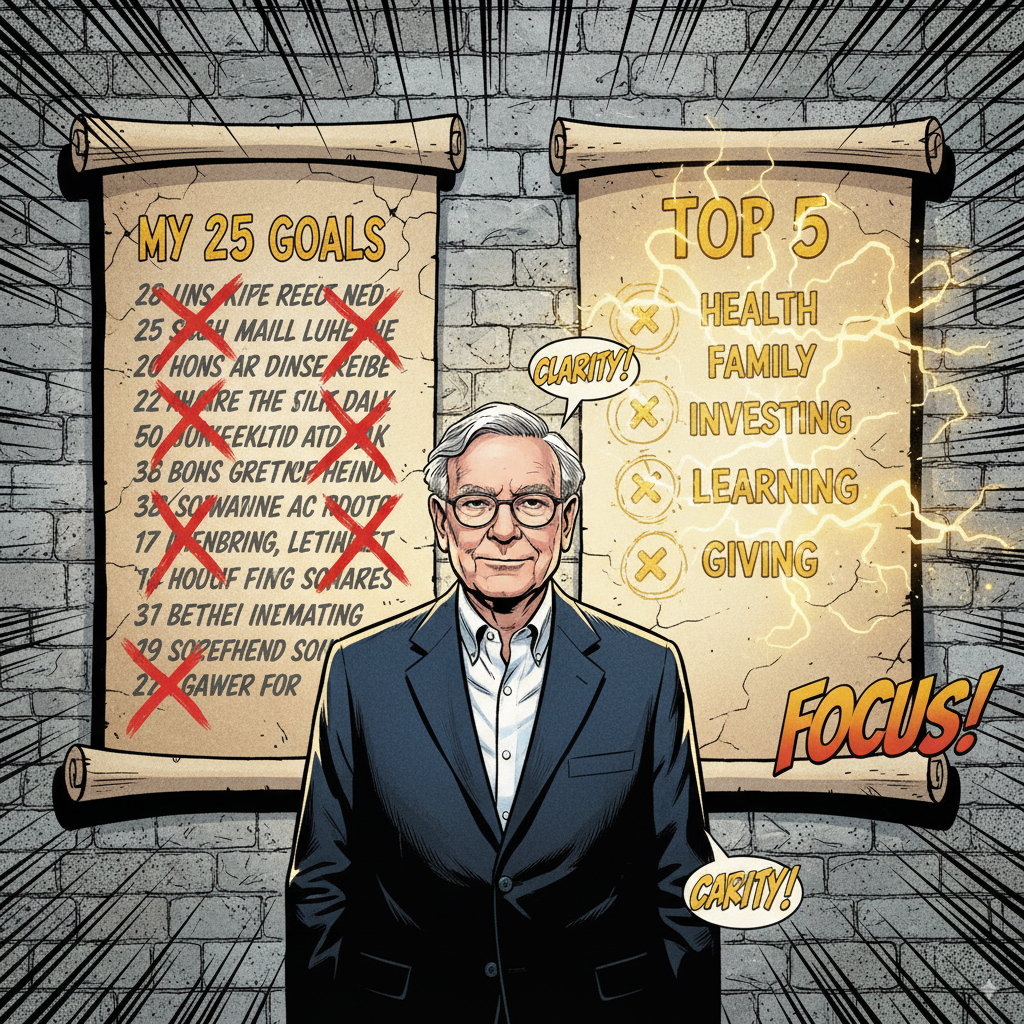The Brutal Truth: Why Too Many Goals Destroy Focus (and How Buffett Wins)
September 17, 2025 | by Nas Digital Growth

Ambition is celebrated everywhere. We’re told to dream big, chase everything, and set as many goals as possible. Yet behind this advice lies a brutal truth: too many goals will quietly destroy your focus. They scatter your attention, drain your energy, and leave you with little to show for all the effort.
Warren Buffett understood this long before the rise of “productivity culture.” Through his famous 25/5 Rule, he demonstrated that success is not about ambition alone ; it is about disciplined focus. In fact, his approach proves that most people fail not because they set the wrong goals, but because they try to chase too many.
This blog will uncover the hidden danger of scattered ambition, explain why Buffett’s strategy works, and show you how to apply the lesson in your own life.
The Hidden Trap of Ambition
At first glance, ambition looks positive. More goals should mean more success, right? But reality plays out differently.
When you set too many goals, three things often happen:
- Your attention fragments. Instead of going deep into one project, you skim the surface of many.
- Your energy drains. Each goal demands decisions, planning, and effort. Over time, you become exhausted without real progress.
- Your results stall. Half-finished projects pile up, leaving you frustrated and guilty.
In other words, ambition without focus doesn’t multiply success ; it divides it.
Buffett’s Famous 25/5 Rule
The clearest demonstration of this principle comes from a story about Warren Buffett and his long-time pilot. One day, the pilot asked Buffett for advice on how to succeed in life and career. Buffett gave him a deceptively simple exercise.
Step 1: Write down 25 goals you want to achieve.
Step 2: Circle the five most important ones.
The pilot did as instructed, creating two lists:
- List A: His top five priorities.
- List B: The other 20.
He then told Buffett he would focus on the five, but also work on the other 20 whenever possible.
Buffett immediately stopped him.
“No, you’ve got it wrong. Those other 20 aren’t secondary. They’re your Avoid At All Costs List.”
That was the shocking twist. The 20 uncircled goals weren’t harmless. They were dangerous distractions that would pull him away from the five that truly mattered.
The Brutal Truth About Too Many Goals
Buffett’s warning highlights something most people never admit: it’s not the obvious time-wasters, like scrolling social media, that stop you. It’s the meaningful but non-essential goals that quietly dilute your focus.
For example:
- You want to start a business, but also pick up photography, write a book, learn a language, and train for a marathon.
- Each feels valuable, but together they overwhelm. Instead of one powerful achievement, you end up with five abandoned attempts.
This is the brutal truth: it’s not lack of ambition that kills progress. It’s the abundance of it.
Why Too Many Goals Destroy Focus
Several psychological and practical forces explain why spreading yourself thin leads to failure.
- Cognitive Overload
Your brain has limited bandwidth. Each additional goal consumes attention. Too many goals create confusion and indecision. - Opportunity Cost
Every hour invested in a lower-priority goal is an hour stolen from your top five. - The Illusion of Progress
Starting new projects feels productive. However, constant switching means nothing gets finished. - Loss of Momentum
Progress compounds when focus is consistent. Splitting attention resets momentum every time.
Together, these forces guarantee that more goals equal less success.
How Buffett Wins with Ruthless Focus
Warren Buffett’s success is not built on doing everything; it is built on doing less with greater intensity. Instead of dabbling in industries he didn’t understand, he deliberately avoided them. His investments went only into businesses with clear and proven value, where his expertise gave him an edge. At the same time, he became known for saying “no” repeatedly to tempting but distracting opportunities. This pattern reveals a universal principle: you don’t win by chasing everything—you win by focusing deeply and doing fewer things better.
Other Examples of Ruthless Focus
Buffett’s lesson isn’t unique to investing. Many world-class achievers follow the same principle.
- Steve Jobs: When he returned to Apple in 1997, he cut dozens of products and focused on just four. That ruthless focus paved the way for the iMac, iPod, and iPhone.
- Serena Williams: She didn’t dabble across sports. She focused entirely on tennis and became one of the greatest athletes in history.
- Elon Musk: Despite multiple ventures, Musk maintains extreme focus within each project—Tesla on electric cars, SpaceX on rockets. He resists side projects outside those domains.
In every case, focus—not sheer ambition—created breakthrough results.
How to Apply the 25/5 Rule Yourself
It’s one thing to understand the principle. It’s another to live it. Here’s how to apply Buffett’s 25/5 Rule step by step.
Step 1: List Your 25 Goals
Write down everything you want to achieve—career ambitions, personal desires, financial targets, even hobbies.
Step 2: Circle the Top Five
Choose only five. To help narrow them down, reflect on a few key questions:
- Do these goals genuinely align with my core values?
- Looking ahead ten years, which ones would I deeply regret not pursuing?
- Finally, which goals are likely to create the biggest ripple effect across other areas of my life?
Step 3: Build the Avoid List
The remaining 20 are not “later projects.” They are distractions. Move them to your Avoid At All Costs List.
Step 4: Focus Daily on the Five
Turn each of your top five into smaller, actionable steps. Build daily habits that push them forward.
Step 5: Review Periodically
Every six months, review your list. Adjust only if your values or circumstances have changed.
Why Saying No Feels Difficult
If this rule is so effective, why doesn’t everyone follow it? The answer is simple: saying no feels uncomfortable.
- Fear of Missing Out: You don’t want to shut doors.
- Social Pressure: Busyness looks impressive. Focus looks boring.
- Ego Rewards: Announcing many goals feels good, even if you never finish them.
Yet every extra “yes” to distraction is a silent “no” to your future.
The Freedom of Focus
Paradoxically, choosing fewer goals doesn’t restrict you; it frees you. With focus, clarity emerges because decisions become simpler and less overwhelming. At the same time, energy is preserved since fewer tasks demand your attention. Most importantly, momentum builds, as consistent effort compounds in one powerful direction. Instead of spreading yourself thin, you start building depth, mastery, and lasting results.
Final Thoughts
The brutal truth is that too many goals destroy focus. They scatter ambition, drain energy, and guarantee mediocrity. Warren Buffett’s 25/5 Rule is a reminder that the path to success is not paved with endless goals, but with ruthless focus on the few that truly matter.
So, write down your 25. Circle your five. Avoid the rest. Commit to them with discipline.
Because in the end, it isn’t the person with the most goals who wins. It’s the one with the clearest focus—just like Buffett.
Watch: Warren Buffett’s 25/5 Rule (Video)
This related video expands today’s theme: success comes not from chasing everything, but from focusing on the few that matter. It explains how Warren Buffett’s simple exercise with his pilot turned into the legendary 25/5 Rule, a strategy that shows why ruthless focus outperforms raw ambition. Watch it first, then use the framework below to cut noise and channel your energy.
The 25/5 Rule
Warren Buffett’s 25/5 Rule begins with a simple exercise: write down 25 goals, then circle the five most important. What makes it powerful, however, is the twist. The other 20 don’t sit quietly in the background; they become your “Avoid At All Costs List.” These secondary goals feel meaningful but are in fact dangerous distractions that dilute focus, drain energy, and delay progress.
Instead of chasing many ambitions, the 25/5 Rule forces you to commit deeply to a chosen few. By cutting the noise, you amplify momentum. The outcome is not just productivity—it’s clarity, depth, and mastery.
Why Ruthless Focus Works
Human psychology explains why the 25/5 Rule is so effective. Every extra goal increases cognitive load, which clutters the mind. Moreover, every “yes” to a secondary ambition is a hidden “no” to your top five. As a result, most people end up with half-finished projects instead of completed achievements.
In contrast, relentless focus compounds progress. Small, consistent steps toward a select few priorities generate momentum, which builds faster than scattered effort. Over time, this single decision—to ignore the 20—creates exponential results.
Stop Chasing Too Many Goals
We all know the thrill of saying, “I’m starting a side hustle,” or “I’m learning three new skills this year.” However, that buzz often fades into unfinished business. The 25/5 Rule flips that pattern. It replaces scattered ambition with targeted execution: keep goals private, circle your five, and ignore the rest.
Begin by identifying one of your top five goals today. Next, take a concrete action—no matter how small—toward it. Repeat daily. Track outputs that matter: deals closed, skills mastered, or projects finished. In doing so, you preserve focus, build proof, and let results speak louder than declarations.
Explore More Growth Playlists
Each blog isn’t just words — it’s a shift in mindset:
🧠 Believe and Become helps you rediscover who you really are beneath the doubt.
🎯 Believe and Visualization shows how to shape your future by rewiring your inner world.
🚀 Dream Big challenges you to expand your vision beyond your current limits.
🏗️ From Nothing to Empire shares how ordinary people turned pain into purpose.
🗣️ He Spoke It First reveals how your words can reshape your entire destiny.
💼 Learn and Earn gives you real-world digital skills to turn into income.
🔁 Miracle of Discipline teaches how tiny consistent habits create massive long-term wins.
⚡ Stop Thinking, Start Doing is your call to action if you’ve waited too long to start.
Each blog isn’t just a read — it’s a mindset shift.
From Silence to Scaling
Quiet focus is the foundation; scalable systems are the multiplier. At Nas Digital Growth, we help you turn ambition into action by aligning four pillars: a mindset that protects your attention, a strategy that bridges vision to execution, a system that converts skills into income, and a brand presence that grows while you stay consistent.

Move from private progress to public proof—on your terms. Design a lean offer, install simple automations, and publish only the milestones that matter. When your process runs quietly and your results speak for themselves, you don’t need louder goals; you need a smarter strategy.
🔗 Get Instant Access to the Free Video + Blog Series — Because your future shouldn’t be a headline, it should be the reality you quietly build.
If you’re ready to stop wasting energy on empty announcements—and start building quietly with results that speak for themselves—then Nas Digital Growth is your partner.
Because following got you stuck. Building sets you free.
Obedience Trained You. Now Ownership Sets You Free.
At Nas Digital, we stand by two life-changing truths:
A mindset that questions the system
And a skillset that builds beyond it
If you’re ready to stop trading time for money — and start building assets, freedom, and long-term value — it begins here. Download the free blueprint. Reach out to our team. Make the move that turns your paycheck mindset into a builder’s path.
🔗 Get the Free Guide Now
💬 Chat With Us on WhatsApp
You’ve heard the story. You’ve seen the blueprint. Now it’s your move.
You’ve heard the story. You’ve seen the blueprint. Now it’s your turn to lead. Join Nas Digital Growth. Learn the skills. Build the future. The empire you want already exists — you just need to start building. Learn. Build. Rise. Because being rejected isn’t the end.
Ready to Transform Your Life?
Get instant access to 100+ world-class programs, 1,000+ guided meditations, a global growth community, and an AI-guided path tailored just for you. Try Mindvalley risk-free for 15 days — no questions, no hassle.
You’ve heard the story. You’ve seen the blueprint. Now it’s your move.
You’ve heard the story. You’ve seen the blueprint. Now it’s your turn to lead. Join Nas Digital Growth. Learn the skills. Build the future. The empire you want already exists — you just need to start building. Learn. Build. Rise. Because being rejected isn’t the end.
Ready to Transform Your Life?
Get instant access to 100+ world-class programs, 1,000+ guided meditations, a global growth community, and an AI-guided path tailored just for you. Try Mindvalley risk-free for 15 days — no questions, no hassle.
Nas Digital Growth Blueprint
A powerful step-by-step system to build your brand, learn digital skills, and turn knowledge into income.
🔗 Get the Blueprint
Nas Digital Consultancy
Your expert partner for content, branding, web design, and growth marketing—designed to help you scale with confidence.
🔗 Explore Consultancy Services
🔗 Visit Our Official Website
FREE Done-For-You Business Blueprint
Get a plug-and-play plan to kickstart your online business—no guesswork, just results.
🔗 Claim Your Free Blueprint
Imagine $10K in 30 Days
Visualize it. Strategize it. Achieve it. This free tool helps you see what’s truly possible.
🔗 Try It Now
NDC Agency (UK-Based Consultancy Site)
Tailored digital solutions for UK, NZ, AU, and Irish businesses.
🔗 Visit NDC Agency
Mindvalley: Your Growth, Amplified
100+ world-class programs, guided meditations, and AI-personalized transformation—all in one platform.
🔗 Try Mindvalley Free for 15 Days
Nas Digital Growth on YouTube
Explore practical strategies on digital skills, online income, and long-term growth. Subscribe today and stay ahead in the digital world.
RELATED POSTS
View all

